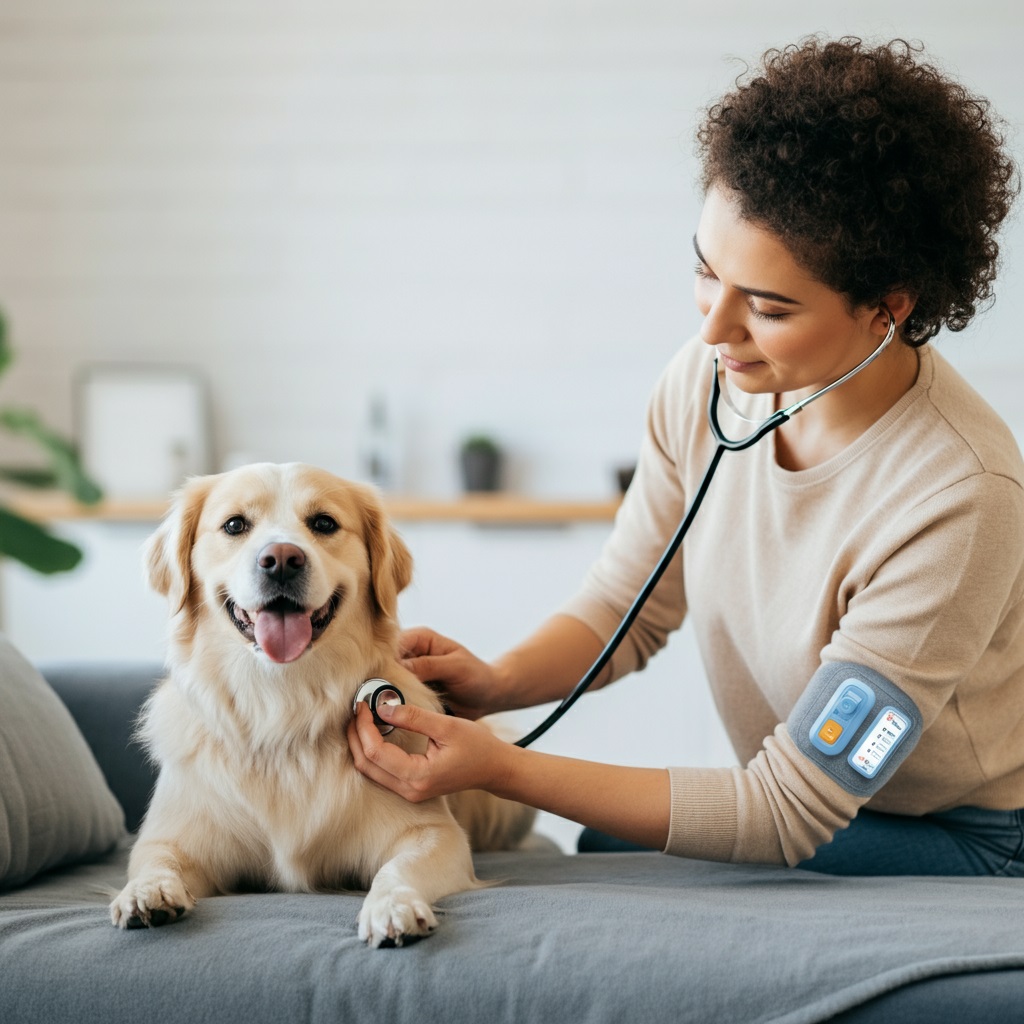
Every pet owner has experienced that moment of concern when their furry friend seems “off.” Maybe your dog is panting more than usual, or your cat has been hiding under the bed all day. Knowing how to monitor your pet’s vital signs at home can provide peace of mind and help you make informed decisions about when to contact your veterinarian.
Learning to check your pet’s vitals is a valuable skill that strengthens the bond between you and your companion while potentially saving their life. This comprehensive guide will teach you how to measure heart rate, respiratory rate, and temperature, recognize warning signs, and create a monitoring routine that works for both you and your pet.
Whether you’re a new pet owner or looking to expand your caregiving skills, these techniques are easier to master than you might think. With practice and the right approach, you’ll become confident in assessing your pet’s health status from the comfort of home.
Understanding Normal Vital Signs
Before you can recognize abnormal readings, you need to establish what’s normal for your specific pet. Vital signs vary significantly between species, breeds, and individual animals.
Dogs
- Heart rate: 60-140 beats per minute (smaller dogs tend toward the higher end)
- Respiratory rate: 10-30 breaths per minute when at rest
- Temperature: 101-102.5°F (38.3-39.2°C)
Cats
- Heart rate: 140-220 beats per minute
- Respiratory rate: 20-30 breaths per minute when relaxed
- Temperature: 100.5-102.5°F (38.1-39.2°C)
Age, activity level, and stress can influence these numbers. Puppies and kittens typically have faster heart rates, while senior pets may have slightly slower rates. Always take multiple readings over time to establish your pet’s baseline.
Monitoring Heart Rate and Pulse
Checking your pet’s heart rate requires a gentle touch and some patience. The goal is to feel the rhythmic beating without causing stress or discomfort.
Finding the Pulse Point
For dogs: Place your hand on the left side of their chest, just behind the front leg where the elbow meets the body. You can also feel for a pulse on the inside of the hind leg where it meets the abdomen.
For cats: Use the chest method primarily, as cats are more sensitive to handling of their legs. Place your palm gently against their chest wall.
Taking the Measurement
Once you locate the pulse, count the beats for 15 seconds and multiply by four. If the rhythm seems irregular, count for a full 60 seconds instead. Keep your pet calm during this process—excitement or anxiety will elevate their heart rate artificially.
Some pets may be more cooperative if you check their pulse while they’re resting or sleeping. Practice this skill when your pet is healthy so you’ll be comfortable with the technique during times of concern.
Measuring Respiratory Rate
Respiratory rate refers to how many breaths your pet takes per minute. This measurement provides insight into their lung function and overall respiratory health.
Observation Technique
Watch your pet’s chest rise and fall while they’re at rest. Count each complete breath cycle (one inhale and one exhale equals one breath) for 30 seconds, then multiply by two. Alternatively, count for a full minute for greater accuracy.
Position yourself where you can clearly see your pet’s ribcage or abdomen moving. Some pets breathe more obviously through belly movement, while others show more chest movement.
When to Measure
Take respiratory rate measurements when your pet is calm and resting. Avoid checking immediately after exercise, play, or stressful situations. Early morning or during afternoon naps often provide the most accurate readings.
Watch for breathing patterns as well as rate. Normal breathing should appear effortless and regular. Labored breathing, gasping, or irregular patterns warrant immediate veterinary attention.
Taking Your Pet’s Temperature
Body temperature provides crucial information about your pet’s health status. Fever often indicates infection or illness, while low temperatures can signal serious medical emergencies.
Equipment Needed
Use a digital thermometer designed for pets, or a human digital thermometer dedicated solely to pet use. Lubricate the tip with petroleum jelly or water-based lubricant before each use.
Step-by-Step Process
Preparation: Have someone help restrain your pet gently but securely. Cats may need to be wrapped in a towel, while dogs might need to be held by a second person.
Insertion: Lift your pet’s tail and gently insert the thermometer about one inch into the rectum. Hold it steady and keep your pet calm with soothing words.
Reading: Wait for the thermometer to beep or signal completion. Most digital thermometers provide readings within 30-60 seconds.
Cleaning: Clean the thermometer thoroughly with rubbing alcohol after each use.
If your pet absolutely won’t tolerate rectal temperature taking, ear thermometers designed for pets offer an alternative, though they may be less accurate.
Creating a Vital Signs Log
Documentation helps you track patterns and communicate effectively with your veterinarian. Create a simple log that includes date, time, heart rate, respiratory rate, temperature, and any observations about behavior or symptoms.
Digital vs. Paper Records
Choose a system you’ll actually use. Some pet owners prefer smartphone apps that can store photos and send reminders, while others find a simple notebook more practical. The key is consistency.
What to Record
Beyond basic vital signs, note:
- Your pet’s activity level before measurement
- Environmental temperature (hot days affect readings)
- Any medications given
- Eating and drinking habits
- Unusual behaviors or symptoms
Sharing with Your Vet
Bring your log to veterinary appointments. This information helps your vet understand your pet’s normal patterns and identify concerning changes more quickly.
Continues after advertising
Recognizing Warning Signs
Knowing when vital signs indicate a veterinary emergency can save your pet’s life. Some situations require immediate professional attention.
Immediate Emergency Signs
Heart rate concerns: Extremely rapid heartbeat (over 200 bpm in dogs, over 250 bpm in cats), very slow heartbeat (under 60 bpm in dogs, under 120 bpm in cats), or irregular rhythms.
Breathing emergencies: Difficulty breathing, gasping, blue or gray gums, respiratory rate over 40 breaths per minute at rest, or any signs of distress.
Temperature alerts: Fever over 103°F (39.4°C), temperature below 100°F (37.8°C), or any temperature change accompanied by lethargy, vomiting, or other concerning symptoms.
Gradual Changes to Monitor
Sometimes health issues develop slowly. Watch for:
- Consistently elevated resting heart rate
- Gradual increase in breathing effort
- Low-grade fever that persists
- Vital signs that don’t return to normal after exercise
Tools and Technology
Modern technology offers pet owners increasingly sophisticated options for home health monitoring.
Basic Equipment
A good digital thermometer remains essential. Choose one with a flexible tip and quick reading time. Keep petroleum jelly on hand for lubrication, and designate the thermometer for pet use only.
Advanced Options
Pet fitness trackers: Devices like FitBark or Whistle can monitor activity levels, sleep patterns, and some basic health metrics continuously.
Smart collars: Some collars now include heart rate monitoring and GPS tracking, though accuracy varies.
Veterinary apps: Several smartphone applications help track pet health data and provide medication reminders.
Cost Considerations
Start with basic tools and upgrade gradually. A simple thermometer and notebook can provide valuable health information without significant investment. Advanced monitoring devices may be worthwhile for pets with chronic conditions or for owners who want comprehensive tracking.
Special Considerations for Different Life Stages
Puppies, kittens, adult pets, and seniors each have unique monitoring needs and challenges.
Young Animals
Puppies and kittens have faster baseline vital signs and may be more difficult to restrain for measurements. Their vital signs also fluctuate more dramatically with activity and excitement. Focus on building positive associations with gentle handling from an early age.
Adult Pets
Healthy adult pets typically have the most stable vital signs. This life stage is ideal for establishing baseline measurements and practicing your technique. Regular monitoring helps detect early signs of developing health issues.
Senior Animals
Older pets may have underlying health conditions that affect their vital signs. They might also be less tolerant of handling, requiring extra patience and gentleness. More frequent monitoring can help catch age-related health changes early.
Building Your Pet’s Comfort Level
Success in home monitoring depends largely on your pet’s cooperation. Start slowly and make the experience as positive as possible.
Desensitization Training
Begin by simply touching the areas where you’ll check vital signs. Reward calm behavior with treats and praise. Gradually increase the duration and intensity of handling as your pet becomes more comfortable.
Creating Positive Associations
Pair vital sign checks with enjoyable activities like treats, gentle massage, or favorite toys. Keep sessions short initially and always end on a positive note.
Managing Stress
If your pet becomes too stressed during monitoring, take a break and try again later. Forced restraint and anxiety will skew your readings and make future attempts more difficult. Some pets respond better to monitoring during calm periods like after meals or during evening relaxation time.
Taking Action on Your Findings
Monitoring vital signs is only valuable if you know how to respond to your findings appropriately.
When to Call Your Vet
Contact your veterinarian if you notice:
- Vital signs outside normal ranges that don’t return to baseline
- Any combination of abnormal readings
- Normal vital signs accompanied by concerning behavioral changes
- Gradual trends away from your pet’s established normal ranges
Emergency vs. Routine Situations
Learn to distinguish between situations requiring immediate emergency care and those that can wait for a regular appointment. When in doubt, call your veterinary clinic for guidance.
Communicating Effectively
When contacting your vet, provide specific information: actual numbers, duration of symptoms, and any relevant circumstances. Your detailed observations help veterinary professionals make better decisions about urgency and treatment.
Read More👉 Post-Vaccine Care for Cats and Dogs
Making Pet Health Monitoring a Routine
Establishing a regular monitoring routine ensures you’ll notice changes quickly and maintain your skills during healthy periods.
Regular vital sign monitoring transforms you from a passive pet owner into an active partner in your pet’s healthcare. The skills you develop will serve you throughout your pet’s lifetime, potentially catching health issues early when treatment is most effective. Remember that home monitoring supplements, but never replaces, regular veterinary care.
Start with basic techniques and build your confidence gradually. Most pets adapt well to gentle, consistent handling, especially when monitoring becomes part of your regular bonding routine. The peace of mind that comes from understanding your pet’s health status is invaluable for both of you.
By mastering these essential skills, you’re taking an important step toward providing the best possible care for your beloved companion. Your veterinarian will appreciate the detailed information you can provide, and you’ll feel more confident in your ability to recognize when professional care is needed.



